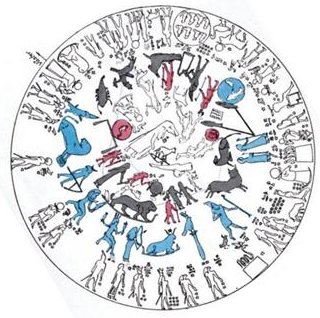In Kjellson there is a useful picture of the round Dendera zodiac, because he has coloured its 'glyphs'.  There are 12 blue figures and Sirius has position 7 counted from left to right. It is the first 'glyph' in the 2nd half of the blue series. I have oriented the picture so Sothis will be at the bottom, corresponding to how deep down from the celestial equator Sirius is. 12 is the logical number of figures, because the Egyptians had defined a calendar with 12 times 3 times 10 = 360 days. Also the black figures are 12 in number. The red are different, they are 7 and Kjellson suggests they represent planets. The bluemarked zodiac is not our well known one but the blackmarked we can recognize. The Fishes with a waterfilled Pegasus Square is at right in the picture and below them is in order from right to left: Aries, Taurus, Gemini, Cancer, Leo etc. Maybe the black zodiac refers to the region north of the celestial equator ('land') and the blue zodiac to the 'water' below the celestial equator. Gemini, for instance, is not far away from the Sothis cow. The figure carrying a henen does not stand at the beginning of the first half of the blue zodiac, he is number 3. The preceding figure is a lion sitting down and looking back - his season is ending. Also the blackmarked Aries ram is looking back. Maybe this backward looking pair demarcate the 'winter' half of the year, 5 blue + 7 black figures. The structure with 2 months ('figures') fetched from the previous 'side' is what we have found also in the rongorongo texts. In e.g. G we must add 64 days (2 months à 32 days) to the 'front side and then tagata toki will be positioned as the henen figure - though at the onset of 'land' instead of at the onset of 'water':
96 = 3 * 32 confirms the interpretation of tagata toki in Ga2-1 initiating 3 * 100 days of Sun. Or maybe we should rather think in terms of 3 times 150:
6 * 36 = 216 is a reasonable number for the last of the Sun glyphs. 546 = 3 * 182 and 5 * 46 = 230 (the number of glyphs on the front side of G). 54 * 6 = day 324 is also a sign for the end of Sun's rule. The 11th kuhane station Akahanga comes only ½ day later, and we have met number 324 several times earlier in this dictionary, for instance at Gb4-3:
324 is still a day of Sun (he is not yet 'buried') and therefore there are 3 'waves' on top of the 'staff' at right in Gb4-3 (in contrast to the 2 waves in Eb7-1). |
||||||||||||||||||||||||||||||||||||||||||||||||||



